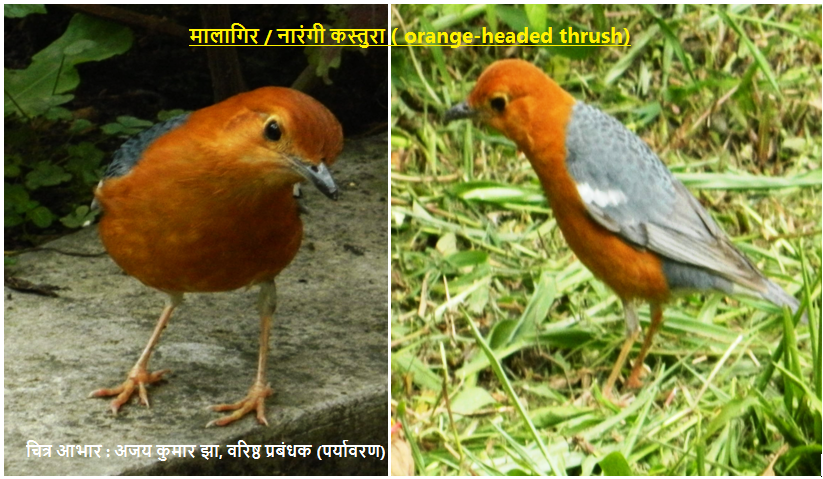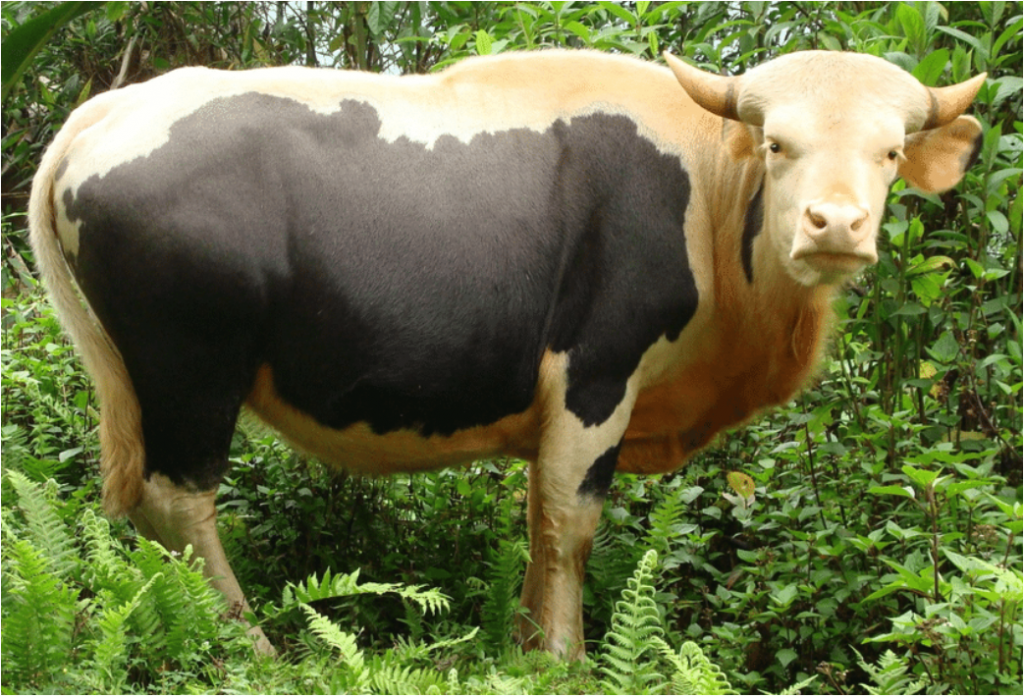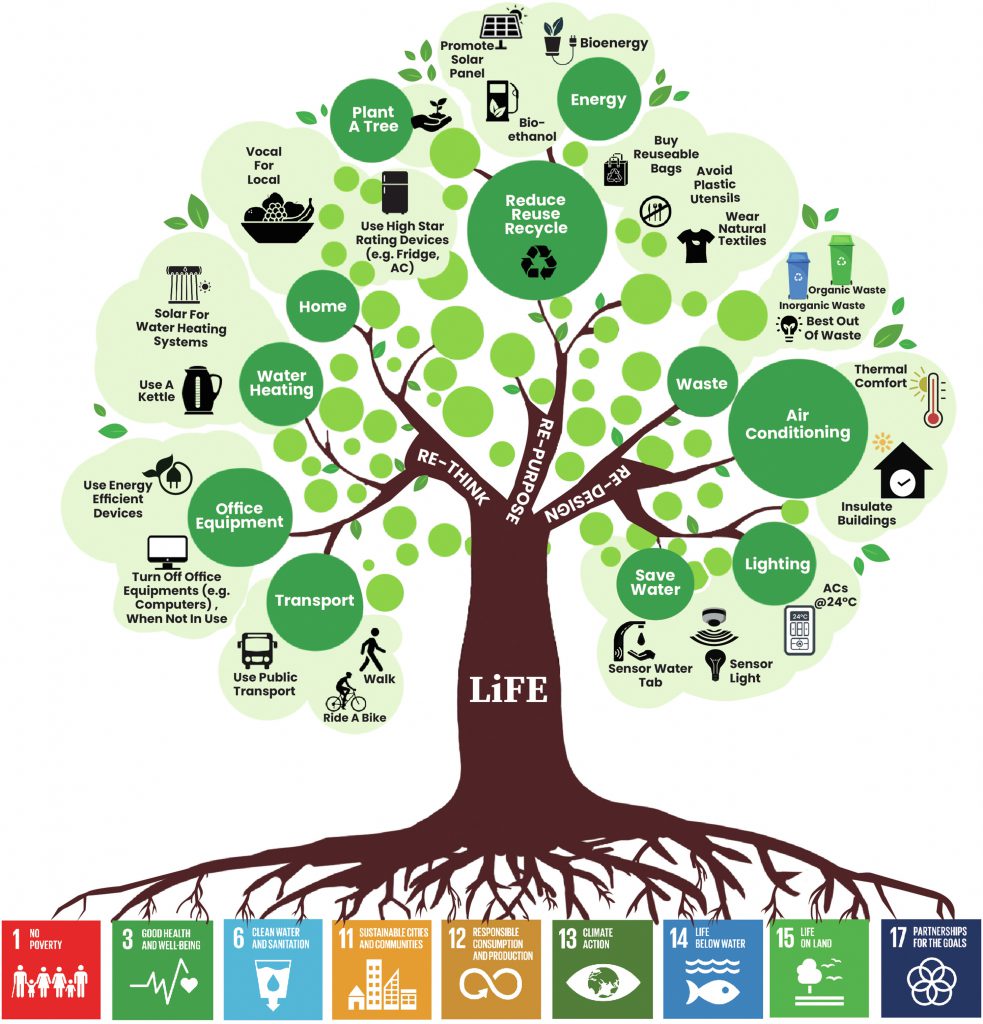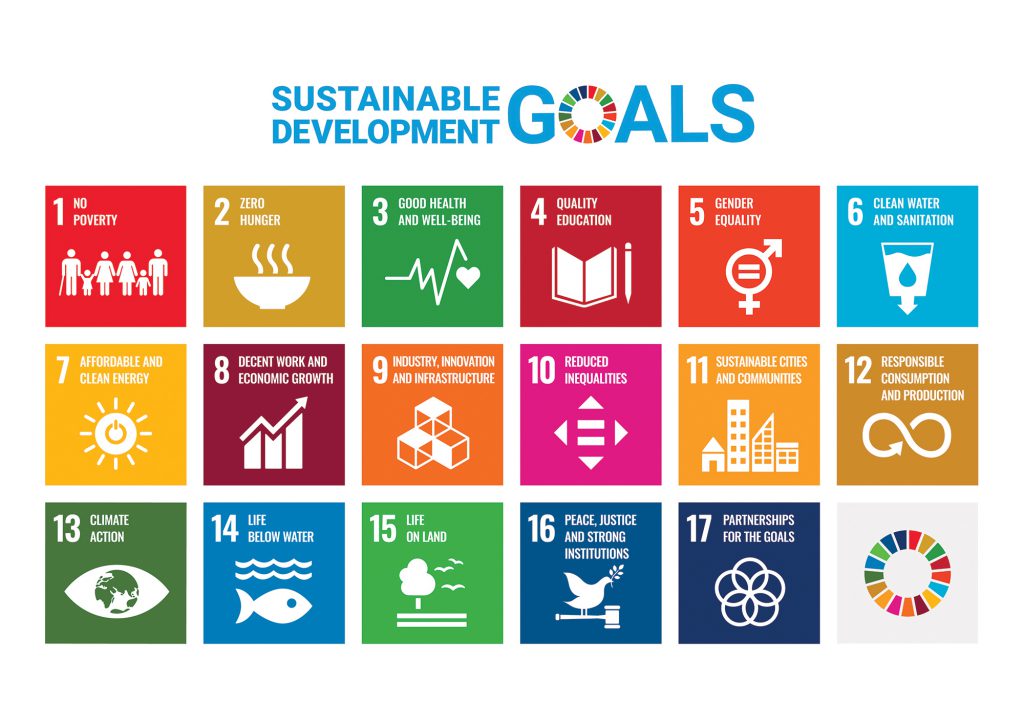NHPC Blog
अंक की तस्वीर (अंक : 21)
मालागिर / नारंगी कस्तुरा
मालागिर / नारंगी कस्तुरा (Geokichla citrina) ) थ्रश परिवार का एक पक्षी है।यह सामान्यता भारतीय उपमहाद्वीप और दक्षिण पूर्व एशिया के घने जंगली इलाकों में पाया जाता है। यह प्रजाति छायादार नम क्षेत्रों को प्राथमिकता देती है ।यह पक्षी सर्वाहारी होता है जो कई प्रकार के कीड़े, केंचुए और फल खाता है। यह पेड़ों पर घोंसला बनाता है लेकिन झुंड नहीं बनाता। इसके नर का ऊपरी हिस्सा एक समान भूरे रंग का होता है और सिर और नीचे का हिस्सा नारंगी रंग का होता है। मादा और युवा पक्षियों का ऊपरी भाग भूरा होता है। यह तस्वीर तीस्ता V पावर स्टेशन परिसर में खींची गई है ।
अजय कुमार झा
वरिष्ठ प्रबंधक (पर्यावरण)
निगम मुख्यालय
मिथुन – अरुणाचल प्रदेश और नागालैंड का राजकीय पशु
Picture source= https://www.researchgate.net/figure/A-female-Mithun-Bos-frontalis-in-her-natural-habitat_fig2_345850491
गेयल (बोस फ्रंटलिस – Bos frontalis) जिसे मिथुन या ड्रंग ऑक्स के नाम से भी जाना जाता है, नागालैंड और अरुणाचल प्रदेश का राज्य पशु है। यह बोविडी परिवार से संबंधित एक लुप्तप्राय जुगाली करने वाली प्रजाति (ruminant species) है, जो पूर्वी हिमालय में पाया जाता है। इसे ‘हाईलैंड्स का जहाज’ और ‘पहाड़ों के मवेशी’ के रूप में भी जाना जाता है। असमिया में, मिथुन को ‘मेथन’ कहा जाता है, इसे अरुणाचल प्रदेश में ‘एसो’ या ‘होहो’ या ‘सेबे’ कहा जाता है, मिज़ोरम में इसे ‘सियाल’ कहते हैं ।यह मणिपुर में ‘सैंडंग’ या ‘वी’ तथा मणिपुर की नागा जनजातियों के बीच ‘सीज़ंग’ के नाम से प्रचलित है। मिथुन पालन एक महत्वपूर्ण परंपरा है जो उत्तर-पूर्व भारत में स्थायी आजीविका से जुड़ी हुई है।
मिथुन की उत्पत्ति
ऐसा माना जाता है कि इसकी उत्पत्ति 8000 साल से भी पहले हुई है। मिथुन को नागा जनजातियों के ‘Ceremonial Ox’ के रूप में वर्णित किया गया है और भारत-म्यांमार सीमा को मिथुन की उत्पत्ति का स्थान बताया गया है। इसकी उत्पत्ति जंगली गौर (बॉस गौरस) या भारतीय बाइसन के प्रत्यक्ष पालतू जानवरों से भी मानी जाती है।
भारत में मिथुन की संख्या
पशुधन गणना, 2019 के अनुसार, मिथुन की संख्या ने पूर्ववर्ती गणना (2012) की तुलना में 26.66% की वृद्धि दर्ज की है और देश में कुल मिथुन संख्या लगभग 3.8 लाख है। अरुणाचल प्रदेश में सबसे अधिक मिथुन आबादी (लगभग 3.5 लाख) है, इसके बाद नागालैंड (लगभग 23 हजार), मणिपुर (लगभग 0.9 हजार) और मिजोरम (लगभग 4 हजार) है।
विशेषताएं
मिथुन की विशेषता इसका बड़ा सिर, भारी शरीर के साथ मजबूत पैर है। माथा आमतौर पर चौड़ा और अवतल होता है। मिथुन विभिन्न रंगों में पाया जाता है लेकिन काला सबसे प्रचुर रंग है। मिथुन के नवजात बछड़े, सुनहरे पीले और भूरे रंग के होते हैं, हालांकि, जैसे-जैसे उम्र बढ़ती है, वे गहरे काले से गहरे भूरे रंग के हो जाते हैं। मिथुन में कूबड़ अनुपस्थित होता है और साथ ही, घरेलू मवेशियों की तुलना में इसकी पूंछ और पैर छोटे होते हैं। इसके कान चौड़े एवं ओसलेप बड़े आकार के होते हैं। 4-5 साल की उम्र के वयस्क मिथुन के शरीर का औसत वजन आमतौर पर 400-500 किलोग्राम होता है। भारत में मिथुन का अधिकतम जीवन काल लगभग 15 वर्ष दर्ज किया गया है। मिथुन ठंडी जलवायु पसंद करता है तथा एक शाकाहारी जानवर है जो घास, झाड़ियां एवं जंगली पत्ते खाता है। उत्तर पूर्व भारत के किसान पहाड़ी, झाड़ीदार जंगलों में समुद्र तल से 1000 से 3000 मीटर की ऊँचाई पर मिथुन का पालन करते हैं।
मिथुन का सामाजिक-सांस्कृतिक महत्व
मिथुन का संबंध आदिवासी संस्कृति से है और कुछ प्राचीन लोककथाओं में मिथुन को सूर्य का वंशज माना गया है। यह स्थानीय जनजातीय आबादी के सामाजिक, सांस्कृतिक और आर्थिक जीवन में महत्वपूर्ण भूमिका निभाते हैं। अरुणाचल प्रदेश के पारंपरिक लोग, इदु मिश्मी तथा आदि लोग मिथुन को पवित्र मानते हैं। उनके लिए मिथुन का मालिक होना परिवार की संपत्ति, समृद्धि और समाज में श्रेष्ठता का प्रतीक माना जाता है। वे न तो मिथुन का दूध पीते हैं और न ही उससे कोई काम करवाते हैं, बल्कि वे मिथुन की देखभाल करते हैं और उसे अपने बच्चे की तरह मानते हैं। वे मिथुन को तब तक जंगल में चरने देते है जब तक कि वे अनुष्ठान या स्थानीय उपभोग के लिए उनका प्रयोग नहीं करते। एक वयस्क मिथुन की औसत कीमत ₹ 60,000-80,000 से लेकर ₹ 1,000,000 रुपए तक होती है। यह परिवार के लिए विवाह फिक्सर भी हैं! दूल्हे के परिवार को शादी तय करने के लिए दुल्हन के परिवार को कम से कम एक मिथुन देना होता है। इसे दुल्हन की कीमत और मुआवजे के रूप में दिया जाता है। इनका मांस विवाह समारोहों, सामुदायिक दावत और अन्य महत्वपूर्ण समारोहों में बहुत ही लोकप्रिय होता है। इस धरती पर मिथुन के जन्म और आगमन के अनुरूप अरुणाचल प्रदेश की आदि जनजातियों द्वारा प्रतिवर्ष ‘सोलुंग’ उत्सव मनाया जाता है। ऐसे त्योहारों के दौरान जानवर की बलि दी जाती है और उनका मांस खाया जाता है।
वर्तमान स्थिति
शिकार और आवास परिवर्तन के कारण इनकी आबादी में गिरावट आ रही है। यह प्रजाति घरेलू पशुओं की बीमारियों जैसे खुर और मुंह की बीमारी एवं रिंडरपेस्ट के लिए भी अतिसंवेदनशील है। यह रोग घरेलू मवेशियों द्वारा फैलते हैं जिन्हें चरने के लिए इनके आवास में ले जाया जाता है। जंगल में प्रजातियों का संरक्षण इसके अस्तित्व और आनुवंशिक विविधता के लिए आवश्यक है।
– डा. अनुराधा बाजपेयी
समूह वरिष्ठ प्रबंधक (पर्यावरण)
पर्यावरण एवं विविधता प्रबंधन विभाग
संदर्भ:
• http://epao.net/epSubPageExtractor.asp?src=education.Jobs_Career.Status_and_prospects_of_Mithun_farming_in_NE_India_By_ICAR_Dimapur
• https://byjus.com/currentaffairs/mithun/#:~:text=Mithun%20animal%20is%20the%20state,%2C%20China%2C%20Bangladesh%20and%20Myanmar.
• Apum, N; Nimasow, G; Nimasow, O; Bapu, T; Bushi, D: Population Status and Conservation Efforts of Bos frontalis (Mithun) in Adi Tribe Inhabited Areas of Arunachal Pradesh, India. NGJI, An International Peer-Reviewed Journal. Vol. 66, No. 1, March 2020 pp- 59-68.
• https://nrcmithun.icar.gov.in
LiFE- Lifestyle for Environment
Picture source = https://www.thelancet.com/journals/lansea/article/PIIS2772-3682%2823%2900098-7/fulltext
India has always inspired the world on environmental protection and now is the time India leads the world by example and conserves our environment. India’s per capita carbon footprint is significantly lower than world average because lifestyle is still rooted in sustainable traditional practices.
Ever noticed why you feel rejuvenated when you inhale fresh clean breeze of air with no pollutants? There is a great sense of belongingness and an invisible connection towards mother Earth while doing so. Breathing unpolluted air has become a rare phenomenon in a city like Delhi and it is spreading fast to other cities as well. This time (winter months of year 2022), Bombay and Bangalore too witnessed very poor levels of Air Quality Index. Air pollution alone is reducing solar power generation by 29%. Himalayan ice sheets have shrunk and there is a global sea level rise prediction between 2-6 feet by year 2100. Reasons can be attributed towards a cumulative effect of all environment damaging activities we do on day to day basis. The sad part is we acknowledge the facts that our habits have degraded the planet to an extent that it is time to act on it but we seldom act. However, our simple habits can bring about myriads of changes towards betterment of the environment and that’s the beauty of it. With this aim, at the 2021 UN Climate Change Conference (UNFCCC COP26), Hon’ble Prime Minister of India, Shri Narendra Modi announced Mission LiFE, to bring individual behaviours at the forefront of the global climate action narrative. The mission named Pro-Planet People (P3) aims to adopt environment friendly lifestyles and drive LiFE as an international mass movement towards “mindful and deliberate utilisation, instead of mindless and destructive consumption” to protect and preserve the environment.It is time to take mindful day-to-day decisions with the sole aim towards improvement of environment.
Water harvesting techniques have been prevalent in India since a very long time- an example of deep rooted traditional practices in India. A visit to Gujarat and Rajasthan will depict popular technique of rain water harvesting via construction of step wells. Even the underground tanks (tankaa) of Tamil Nadu, check dams (johads) of Rajasthan and the Zabo system of Nagaland that deposit the water in pond-like structures on terraced hillsides have been in use for a long time.
For majority of people, happiness lies in buying new clothes but buying quality garments and making them last is all together a different experience. Our grandparents had only those many clothes that they could take care of. With minimal clothing they led a happy and satisfied life. Unfortunately clothes from fast fashion brands aren’t meant to last really, and it’s important that we realise that, and switch to buying thoughtfully. Vintage and pre-loved clothing should gain momentum. There is a need for a change from throw away culture to circular economy. Simple actions like carrying a steel water bottle/ tumbler to office meetings can be a good start. This will greatly reduce generation of plastic waste from commercial buildings. In addition, minimising electricity consumption and hand-washing and sun-drying of clothes can serve as foundations for LiFE.
Each and every individual must take the responsibility to take care of Mother Earth. Such simple actions can be easily practiced by us for betterment of the environment and save the planet from climate change. Let’s aim to be PRO-PLANET PEOPLE.
Shreya
DM(Env.)
Corporate Office
References:
- https://www.mygov.in/life/
- https://www.wto.org/english/tratop_e/envir_e/session_13_life_deck_for_global_delegates_20_oct_2022.pdf
- https://mopng.gov.in/files/uploads/Concept-Note—Mission-LiFE-(1).pdf
ENERGY TRANSITION IN INDIA
Picture source = https://vajiramias.com/current-affairs/global-energy-transition-index/5c99d4491d5def13690f1126/
India’s energy transition phase started in the early 1980s when it set up a dedicated governing body for non-conventional energy matters, called the Ministry of New and Renewable Energy (MNRE), the first country to do so in the world. In 1986, India set up its first wind power plants in Maharashtra, Gujarat and Tamil Nadu and has reached total wind power installed capacity of about 13 GW by 2010. In 2009, India had set up its first solar power plant in Punjab with a capacity of 02 MW. Since then, India has been working toward increasing its dependency on non-conventional renewable and non-emission energy sources.
Contribution of India to clean energy
India has installed electricity capacity of 172.72 GW from non-fossil fuels sources as on 31.10.2022. In fact, India’s new draft National Electricity Plan 2022 sees about 18GW reduction in coal capacity by 2030 when compared to the Optimal Generation Capacity Mix report released in 2020.
India is one of the largest energy consumers and the third-largest renewable energy producer in the world. To strengthen its energy transition, the Government has implemented several policies and schemes to encourage manufacturing and research in renewable energy sector. In the recent Budget 2022–23, India allocated Rs. 19,500 crore (US$ 2.61 billion) for domestic solar cells and module manufacturing. Similarly, Rs. 1,050 crore (US$ 141 million) was allocated to the wind power sector. India aims to become a major manufacturer in various sectors including solar equipment, batteries and semiconductors.
Financial Support for Energy Transition
Government has started a range of initiatives to support India’s Energy Transition including a Rs 21,650 Crore scheme to encourage the setting up the Grid scale Battery Energy Storage System (BESS) and Rs 3,765 Crore in viability grant for such projects and reduced import duties on parts to build BESS. Furthermore, Government may offer a 5% interest subvention for new energy efficient technologies and a credit guarantee of 75% of the loan amount or Rs. 15 Crore per project to small and medium enterprises deploying energy efficient technologies. Help in creating job opportunities in these states and with revenue generation for their economy.
Transitioning to clean energy from fossil fuels is need for combating global warming. By helping to control global warming, India can help to mitigate the danger associated with the climate change. Energy storage is expected to play key role in helping India meet its commitment to net zero carbon emission by 2070 increasing non fossil energy capacity to 500 GW by 2030 and reducing the carbon intensity of its economy by 45% from 2005 level.
– Dharam Pal Rathore
Deputy General Manager (Environment)
Teesta-VI HE Project
Reference:
1. India Brand Equity Foundation; INDIA’S ENERGY TRANSITION AND INNOVATION COLLABORATION
2. Mint New Delhi, 21-12-2022 Budget to press for Energy Transition
किसिंग गौरामी : एक्वेरियम परिदृश्य
Picture source =https://aquariumfishonline.com.au/product/pink-kissing-gourami-helostoma-temminkii-7cm/
किसिंग गौरामी (Helostoma temminkii), जिसे किसिंग फिश या किसर के रूप में भी जाना जाता है, हेलोस्टोमैटिडी (Helostomatidae ) परिवार की मध्यम आकार की उष्णकटिबंधीय क्षेत्र व मीठे पानी में पाये जानी मछली है। इस मछली का उद्गम स्थल थाईलैंड से लेकर इंडोनेशिया तक है। वैसे तो यह सजावटी मछली के तौर पर सर्वत्र प्रसिद्ध है, लेकिन इन मछलियों के मूल देशों (दक्षिण पूर्व एशिया) में ये खाद्य मछली के रूप में भी प्रचलित हैं, क्यूंकी वहाँ इनकी खेती फार्म स्तर पर की जाती है। दक्षिण पूर्व एशियाई देशों में इन मछलियों को स्टीमिंग, बेकिंग, ब्रोइलिंग और पैन फ्राइंग के उद्देश्य से ताजा उपयोग में लाया जाता है।
किसिंग गौरामी मछली का सबसे विशिष्ट भाग इसका मुंह होता है, क्यूंकी इसके मुंह की बनावट की वजह से ही यह बाकी मछलियों से भिन्न होती है। इसी विशेषता के कारण इनका अनोखा नामकरण प्रतीत होता है। इन मछलियों में किसी भी प्रकार की बाहरी यौन द्विरूपता नहीं होती, इसलिए इनके लिंगों में बाह्य तरीके से अंतर कर पाना सरल कार्य नहीं होता। यह मछली अन्य मछलियों, पौधों और आस-पास के वस्तुओं पर अपनी अजीबो-गरीब “किसिंग” व्यवहार के कारण जलशालाविद के बीच काफी लोकप्रिय है। नर एवं मादा किसिंग गौरामी आपस में अक्सर मुंह से मुंह लड़ाते हैं, और एक दूसरे को विपरीत दिशा में धकेलते है, जो प्रायः किसिंग प्रक्रिया जैसा प्रतीत होता है। इन मछलियों का निर्यात जापान, यूरोप, उत्तरी अमेरिका, आस्ट्रेलिया और दुनिया के अन्य हिस्सों में वृहत पैमाने पर किया जाता है।
ये मछलियाँ अपने से समान आकार की दूसरे मछलियों के प्रति सहिष्णुता का परिचय देती हैं, लेकिन बाकी अन्य मछलियों का पीछा कर, तंग कर उन्हें पीड़ा पहुंचाती है, जिससे टैंक (एक्वेरियम) में मौजूद अन्य मछलियाँ असहज महसूस करती हैं। नर मछलियाँ प्रायः एक दूसरे को किसिंग गतिविधि की चुनौती देते रहते हैं। हालांकि, यह प्रक्रिया इनके लिए कभी भी घातक नहीं होता, लेकिन लगातार ऐसा करने से दूसरी मछलियाँ तनाव में आकार अपनी जान गवा सकती हैं। फलस्वरूप एक्वेरियम में इन मछलियों के साथ अगर दूसरे प्रजाति के मछलियों को रखना हो, तो इस बात का विशेष ध्यान रखना चाहिए कि वे सभी इनके आकार के बराबर हो।किसिंग गौरामी अपने भोजन के उद्देश्य से अक्सर अन्य मछलियों की त्वचा से बलगम चूसते हैं, जिससे शिकार मछलियों की त्वचा पर संक्रमण होने से जान जाने का खतरा बना रहता है।
ये मछलियाँ एक्वेरियम टैंक में मौजूद शैवाल को अपना आहार बना लेती हैं, इसलिए एक्वेरियम टैंक में शैवाल के विकास को नियंत्रित करने के लिए ये मछलियाँ बहुत उपयोगी होती हैं। मछलियों द्वारा टैंक में मौजूद आधार सतह की खुदाई को रोकने के लिए और शैवाल के विकास हेतु पर्याप्त सतह क्षेत्र उपलब्ध कराने के लिए, सब्सट्रेट में बड़े-व्यास वाली बजरी और पत्थरों का होना आवश्यक होता है। एक्वेरियम के पिछले शीशे को नियमित रखरखाव के दौरान साफ नहीं किया जाना चाहिए, क्योंकि वहां उगने वाले शैवाल, इन मछलियों के लिए भोजन आपूर्ति का कार्य करते हैं।अधिकांश जीवित पौधे, मछलियों के चरने से समाप्त हो जाते हैं, इसलिए अक्वेरियम को अलंकृत रूप में बरकरार रखने के उद्देश्य से अक्वेरियम में ज्यादातर अखाद्य पौधों जैसे: जावा फ़र्न, जावा मॉस या प्लास्टिक के पौधों को अधिष्ठापित करना उचित रहता है।
किसिंग गौरामी मछलियाँ सर्वाहारी होती हैं और इन्हें अपने आहार में पौधे और पशु पदार्थ, दोनों की आवश्यकता होती है। ये किचन में पके हुए सब्जियों जैसे लेट्यूस (Lactuca sativa) और सूक्ष्म जीवजन्तु भोजन के रूप में स्वीकार करती हैं। एक्वेरियम में इनके लिए पानी की कठोरता (Hardness) 5 से 30 dGH और pH 6.8 और 8.5 के मध्य होना चाहिए तथा पानी का तापमान 22 और 28 डिग्री सेल्सियस (72 और 82 डिग्री फारेनहाइट) के मध्य होना चाहिए। हालांकि प्रजनन करते समय, शीतल जल (सॉफ्ट वॉटर) को प्राथमिकता दी जाती है। चूंकि ये मछलियाँ घोंसले का निर्माण नहीं करती है, इसलिए पानी की सतह पर रखे लेट्यूस के पत्ते स्पौनिंग हेतु माध्यम के रूप में कार्य करते हैं। लेट्यूस (Lactuca sativa) पर बैक्टीरिया और इन्फ्यूसोरिया जैसे सूक्ष्म जीवजन्तु के पनपने से इनकी भोजन आपूर्ति पूरी हो जाती है। एक्वैरियम में किसिंग गौरामी की अधिकतम लंबाई 30 से 40 सेमी (12 और 15.5 इंच) के मध्य होती है। सामान्य तौर पर टैंक और स्ट्रीम में इन मछलियों का औसत जीवन काल 5 से 7 वर्ष तक दर्ज किया गया है।
-मनीष कुमार, उप प्रबंधक (फिशरीज)
निगम मुख्यालय
संदर्भ :
- https://www.fishbase.de/summary/500
- https://animaldiversity.org/accounts/Helostoma_temminkii/
- https://www.cabi.org/isc/datasheet/80320
SUSTAINABLE DEVELOPMENT GOALS
Picture Source = https://education.nationalgeographic.org/resource/sustainable-development-goals/
The Sustainable Development Goals (SDGs) are the shared blueprint to achieve a better and more sustainable future for all. They address the global challenges faced which include poverty, inequality, climate change, environmental degradation, peace and justice. The SDGs aim to transform our world. The 17 Goals were adopted by all United Nations Member States in September 2015 as part of the 2030 Agenda for Sustainable Development and sets out a 15-year plan to achieve the Goals and their related targets. The 17 Goals are interconnected, apply to all countries, and need to be carried out by all stakeholders – governments, private sector, civil society, the United Nations and others, in a collaborative partnership. The 17 Sustainable Development Goals in brief are as under:
SDG-1: No Poverty: To ensure that all men and women, in particular the poor and the vulnerable, have equal rights to use economic resources, as well as to access basic services, ownership and control over land and other forms of property, inheritance, natural resources, appropriate new technology and financial services.
SDG-2: Zero Hunger: To ensure sustainable food production systems and implement resilient agricultural practices that increase productivity and production, that help sustain the ecosystems, that strengthen capacity for adaptation to climate change, extreme weather, drought, flooding and other disasters and that progressively improve land and soil quality.
SDG-3: Good Health and Wellbeing: To strengthen the prevention and treatment of substance abuse, including narcotic drug abuse and harmful use of alcohol; end the epidemics of AIDS, tuberculosis, malaria, water-borne diseases and other communicable diseases; universal health coverage, to support the research and development of vaccines and medicines etc.
SDG-4: Quality Education: To ensure all learners acquire knowledge and skills needed to promote sustainable development, including among others through education for sustainable development and sustainable lifestyles, human rights, gender equality, promotion of a culture of peace and non-violence, global citizenship, and appreciation of cultural diversity and culture’s contribution to sustainable development.
SDG-5: Gender Equality: To end discrimination, eliminate all forms of violence against women and girls; to ensure effective participation and equal opportunities for leadership at all levels of decision-making in political, economic and public life.
SDG-6: Clean Water and sanitation: To improve water quality by reducing pollution, eliminating dumping and minimizing release of hazardous chemicals and materials, halving the proportion of untreated wastewater and substantially increasing recycling and safe reuse globally; access to adequate and equitable sanitation and hygiene.
SDG-7: Affordable and Clean Energy: To ensure universal access to affordable, reliable and modern energy services.
SDG-8: Decent Work and Economic Growth: To eradicate forced labour, end modern slavery and human trafficking, and prohibition of child labour. To promote development-oriented policies that support productive activities, decent job creation, entrepreneurship, creativity and innovation, and encourage the formalization and growth of micro, small and medium-sized enterprises, including through access to financial services.
SDG-9: Industry, innovation and Infrastructure: Develop quality, reliable, sustainable and resilient infrastructure, including regional and transborder infrastructure, to support economic development and human well-being, with a focus on affordable and equitable access for all.
SDG-10: Reduce Inequalities: Facilitate orderly, safe, regular and responsible migration and mobility of people, official development assistance and financial flows.
SDG-11: Sustainable Cities and Communities: Access to adequate, safe and affordable housing and basic services; sustainable transport systems; sustainable urbanization; public spaces; strengthening national and regional development planning; holistic disaster risk management.
SDG-12: Responsible Consumption and Production: To achieve the environmentally sound management of chemicals and all wastes throughout their life cycle, in accordance with agreed international frameworks, and significantly reduce their release to air, water and soil in order to minimize their adverse impacts on human health and the environment.
SDG-13: Climate Action: Take urgent action to combat climate change and its impacts; maintenance of environment and natural resources.
SDG-14: Life below Water: Conserve and sustainably use the oceans, seas and marine resources for sustainable development.
SDG-15: Life on Land: Protect, restore and promote sustainable use of terrestrial ecosystems, sustainably manage forests, combat desertification, and halt and reverse land degradation and halt biodiversity loss; to end poaching and trafficking of protected species of flora and fauna and address both demand and supply of illegal wildlife products.
SDG-16: Peace, Justice and strong Institutions: Promote peaceful inclusive societies for sustainable development, provide access to justice for all and build effective, accountable and inclusive institutions at all levels.
SDG-17: Partnership for the Goals: Strengthen the means of implementation and revitalize the global partnership for sustainable development.
Sustainable Development Goals and India
NITI Aayog has constructed the SDG India Index spanning across 13 out of 17 SDGs (except SDGs 12, 13, 14 and 17). The Index tracks the progress of all the States and Union Territories (UTs) on a set of 62 National Indicators, measuring their progress on the outcomes of the interventions and schemes of the Government of India. The SDG India Index is intended to provide a holistic view on the social, economic and environmental status of the country and its States and UTs. The SDG India Index is an aggregate measure which can be understood and used by everyone—policymakers, businesses, civil society and the general public. It has been designed to provide an aggregate assessment of the performance of all Indian States and UTs, and to help leaders and change makers evaluate their performance on social, economic and environmental parameters. It aims to measure India and its States’ progress towards the SDGs for 2030.
– Ritumala Gupta
Senior Manager (Environment)
Corporate Office
Reference:
1. https://www.un.org/
2. https://niti.gov.in/
नागफनी
Picture source = https://www.plantaeparadise.com/Echinopsis-hybrid-p543258858
(बतकही/ प्रसंग)
फूलों की दुकान का मुआयना करती रूतु की सरसरी नजरें कंटीली नागफनी की खूबसूरती पर जा कर अटक गईं और अब नागफनी का वो नन्हा पौधा उसके शयनकक्ष की सजीवता को बढ़ा रहा था। वस्तुतः रूतु गई तो थी फूल के पौधे लेने पर उसने कंटीली नागफनी में ज्यादा अपनापन पाया। रूतु को नागफनी अपनी फ़ितरत से मिलती-जुलती सी लगी तो उसे संग ले आई। लंबे अरसे से सिरहाने पड़ा खाली तिपाया उसे कचोट रहा था। वैसे भी कहने वाले से ज्यादा उसे सुनने वाले की जरूरत थी – एक मौन श्रोता !
नागफनी (कैक्टस) को सामान्यतः घर के अंदर क्या, घर के आस-पास भी देखना पसंद नहीं किया जाता है, पर “रूतु” उसे अपने घर के अंदर ही नहीं बल्कि अपने शयनकक्ष में रखने के लिए खरीद लाई थी। “नागफनी” – खाद/पानी व देखभाल के बिना भी जीवित रहने की कूवत रखती है। अपनी जिजीविषा को खुद में समेटे, संरक्षित किए – काफी हद तक आत्मनिर्भर ! कांटों के खूबसूरत लिबास में इठलाती हुई, और … कांटे भी तेज़, धारदार, नुकीले और तीखे।
वास्तव में ये कांटे नागफनी की पत्तियां हैं, जो कि कांटों में तब्दील हो गई हैं – वातावरणवश/ परिस्थितिवश ताकि तने में सहेजी गई नमी/ प्राणऊर्जा उड़न-छू न हो पाए। प्रकृति की गोद में तपती धूप का सामना करना है, भीषण गर्म हवा के थपेड़े झेलने हैं, चुभती ठंढ भी सिहरा के गुजर जानी है और वो भी …. अनवरत/ निरंतर। जड़ें जितनी गहरी होंगी, उतना जीवन रस सोखेंगी, उतनी ही मजबूती रहेगी स्वाभिमान सहित तन कर खड़े होने में।
रूतु अब पहले से भी ज्यादा खुश है। सुबह घर से निकलते वह नागफनी को कमरे से बाहर धूप में रख जाती है ताकि नागफनी को अकेलापन न महसूस हो और फिर शाम को वापस नागफनी को कमरे के अंदर ले आती है। रात के ढलने तक रूतु और नागफनी खामोशी में बातें करते हैं।
-पूजा सुन्डी
उप प्रबंधक (पर्यावरण)
निगम मुख्यालय






